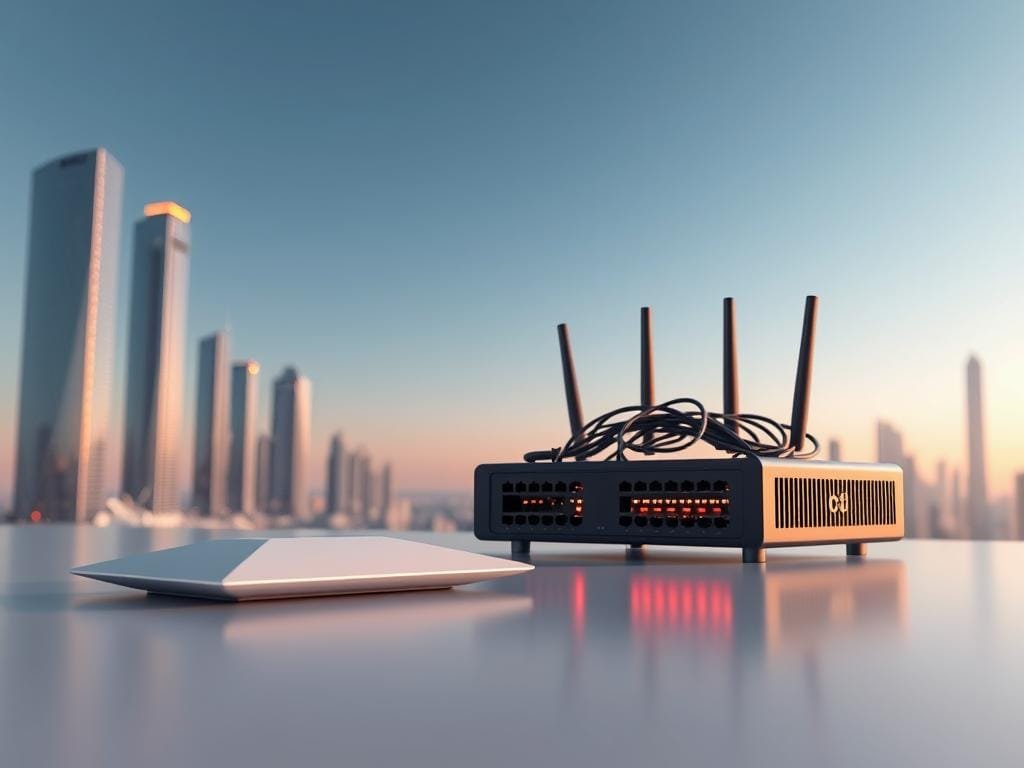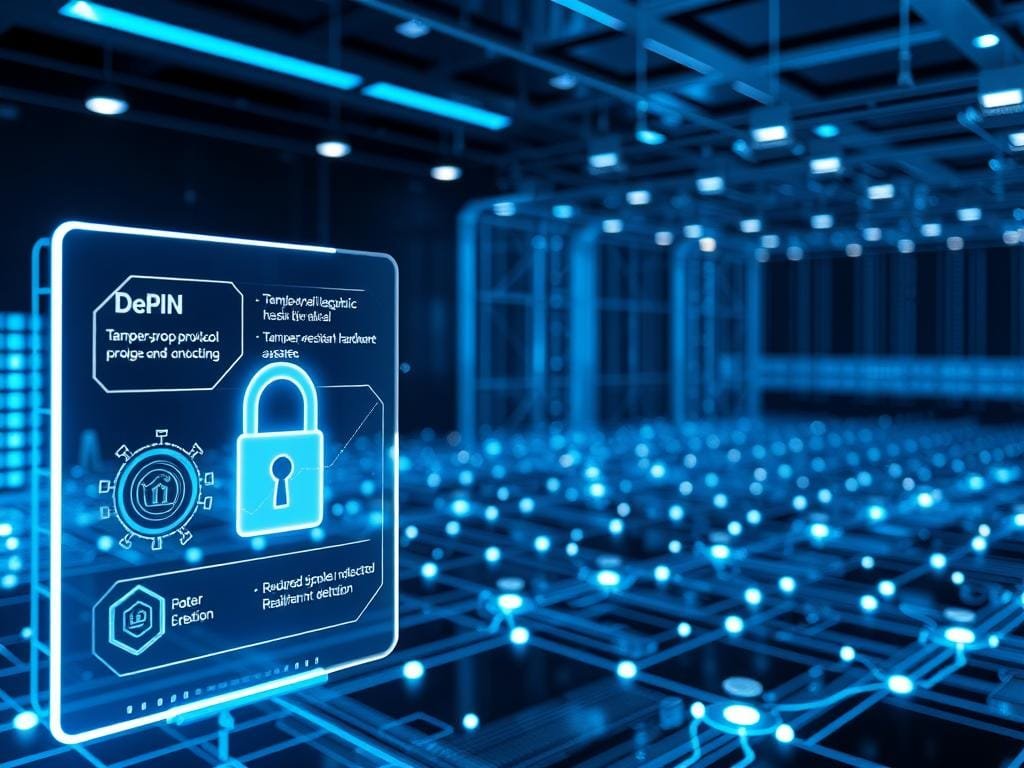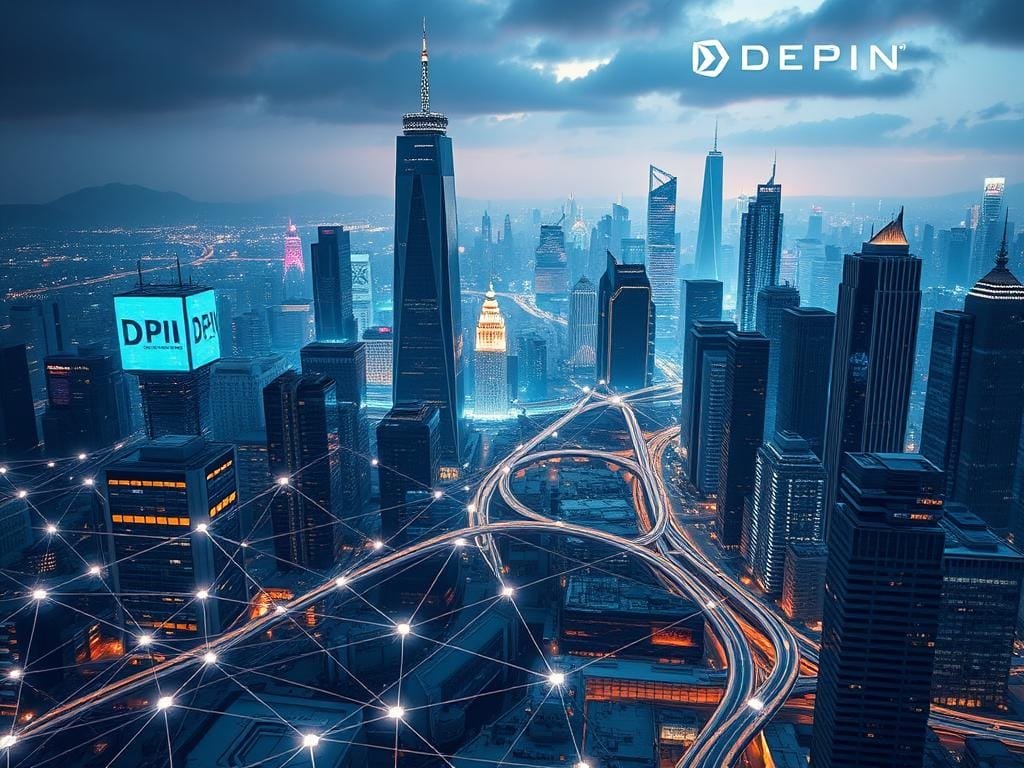Imagine a world where blockchain technology is part of your daily life. It makes things more secure and efficient. DePIN is a system that rewards people for services like WiFi, energy, or data storage.
Joining a DePIN network is easy. Just download an app. This makes it simple for everyone to get involved. A recent article on CoinTelegraph talks about how DePINs are changing the tech world. They’re creating a future where people work together and everyone is treated fairly.
Key Takeaways
- DePIN is a system that bridges the digital and real worlds using blockchain technology.
- Participants are rewarded with tokens for providing essential services.
- DePIN networks can be accessed by downloading an app.
- This technology promotes a collaborative and equitable tech ecosystem.
- DePINs are being deployed on an enterprise level and via smartphones.
What is DePIN?
DePIN changes how we manage physical systems. It uses blockchain for a more open and democratic way. This makes secure online login better and adds enhanced security measures to the network.
Definition of DePIN
DePIN uses blockchain to share physical system management. It’s about shared ownership and open-source ideas. This brings new ideas and includes more people. For more on DePIN, check out CoinTelegraph’s explanation.
DePIN aims to have a network run by many, not one. This makes it safer and uses biometric verification for secure logins.
Historical Context
DePIN came from wanting better, community-focused infrastructure. Before, infrastructure was managed by one person or group. This led to problems. DePIN fixes these with blockchain’s help.
| Aspect | Traditional Infrastructure | DePIN |
|---|---|---|
| Management | Centralized | Decentralized |
| Security | Vulnerable to single-point failures | Enhanced security through decentralization |
| Ownership | Single entity ownership | Shared ownership among participants |
Importance in Today’s Technology
Today, DePIN is key for secure, adaptable, and community-focused infrastructure. It uses enhanced security measures and shared ownership. This makes infrastructure better and more efficient.
As we go on, DePIN will become even more important. It’s great for industries needing security and reliability. Its use of biometric verification and secure online login makes it very useful.
How DePIN Works
DePIN uses a network of physical nodes and blockchain tech. This mix makes a strong, safe base for many uses.
Underlying Technology
DePIN’s tech combines blockchain and IoT devices. Blockchain technology keeps records safe and clear. IoT devices like sensors and routers make up the network’s physical part.
User-friendly authentication is key. It lets users safely and easily use the network. This is done with top-notch encryption and security methods.
Network Components
The network has different nodes that help it work well. These nodes are:
- Sensors that gather data from the world
- Routers that help nodes talk to each other
- Hotspots that offer wireless access
Together, these parts make using the network smooth and easy for users.
| Network Component | Function |
|---|---|
| Sensors | Collect environmental data |
| Routers | Facilitate node communication |
| Hotspots | Provide wireless connectivity |
Data Security Features
DePIN keeps user data safe and private. It uses strong security, like encryption and secure login, to block bad access.
With blockchain and IoT, DePIN builds a safe, dependable base. It supports many uses, like managing supplies and building smart cities.
Applications of DePIN
DePIN is versatile and changes how we use important systems like energy grids, communication networks, and transportation. It makes these systems work better.
Real-World Use Cases
DePIN has many uses in real life. For example, in energy, it helps manage grids by tracking energy use in real time. This makes energy use more efficient and cheaper.
- Efficient Energy Grids: DePIN makes smart grids that adjust energy based on demand.
- Enhanced Communication Networks: It helps telecoms make networks more reliable and fast.
- Smart Transportation Systems: DePIN helps create systems that cut down on traffic and make travel safer.
Industries Benefiting from DePIN
Many industries are using DePIN. These include:
- Energy: It optimizes energy use and distribution.
- Telecommunications: It boosts network security and efficiency.
- Logistics: It improves supply chain management with real-time tracking.
As DePIN gets better, it will help these industries even more. This will lead to better efficiency and lower costs.
Future Possibilities
DePIN’s future is bright, with many new uses coming. It will be used in smart cities and advanced IoT devices.
“The integration of DePIN with other emerging technologies like AI and IoT will unlock new possibilities for infrastructure management and beyond.” – Expert in Blockchain Technology
By using DePIN, industries can lead in technology. They will enjoy better security, efficiency, and cost savings.
Benefits of DePIN
DePIN is changing how we manage infrastructure with its enhanced security, increased efficiency, and cost-effectiveness. It offers many advantages, from better data protection to smoother operations.
Enhanced Security
DePIN keeps your data safe by not storing it in one place. It spreads it across a network, making it hard for hackers to get to. This enhanced security measure is key in today’s world, where data breaches can cause big problems.
- Data is encrypted and spread out, lowering the chance of a single point of failure.
- DePIN’s open design lets you watch data in real-time and act fast on threats.
- Blockchain technology makes data unchangeable and safe.

Increased Efficiency
DePIN makes managing infrastructure better by automating tasks and cutting through red tape. This means you can set up services and manage resources faster. For example, it helps with quick data sharing and teamwork on big projects.
- Automated tasks cut down on mistakes caused by people.
- DePIN’s design lets you share data and work together in real-time.
- It’s great for big projects, where working together and sharing data is key.
To learn more about DePIN’s impact on infrastructure in the Web3 era, check out this article for more details.
Cost-Effectiveness
DePIN saves money by cutting out middlemen and lowering the risk of expensive data breaches. It also automates tasks and boosts efficiency, saving even more.
- Less money spent on operations thanks to automation and streamlined processes.
- Lower chance of expensive data breaches with better security.
- Better use of resources, leading to overall savings.
In summary, DePIN’s benefits go beyond just security. It also makes things more efficient and cheaper, making it a great tool for the future of managing infrastructure.
Challenges Facing DePIN
DePIN’s journey to widespread acceptance is filled with challenges. These range from technical issues to regulatory uncertainties. It’s important to understand these hurdles as you explore DePIN’s possibilities.
Technical Limitations
DePIN faces significant technical challenges. Ensuring secure online login and network integrity is key. Integrating blockchain technology with existing systems can be complex.
Scalability issues also pose a problem. As DePIN grows, it needs more robust infrastructure to support it.
Regulatory Concerns
DePINs must navigate regulatory hurdles, including unclear crypto laws. Balancing blockchain transparency with data privacy is a challenge, with GDPR in the EU being a major concern.
The use of biometric verification adds complexity. It must comply with legal standards in various jurisdictions.
| Regulatory Issue | Description | Impact on DePIN |
|---|---|---|
| Unclear Crypto Regulations | Lack of clear guidelines on cryptocurrency | Complicates compliance |
| Data Privacy | Balancing transparency and privacy | Challenges with GDPR compliance |
| Biometric Verification | Legal standards for biometric data | Varying jurisdictional requirements |
Adoption Barriers
Adoption barriers are a significant challenge. For DePIN to succeed, it needs widespread adoption. This can be hindered by a lack of understanding or trust in the technology.
To overcome these barriers, educating users about DePIN’s benefits and security is essential. You can learn more about DePIN’s challenges and future on platforms like Bitskwela.
DePIN vs. Traditional Networks
DePIN changes how we see infrastructure, moving away from old ways. It uses shared ownership and open-source principles. This brings new ideas and makes everyone feel included.
This new way of doing things changes how we manage and keep infrastructure up. Let’s look at what makes DePIN different from traditional networks.
Key Differences
DePIN is all about being decentralized, unlike traditional networks that are centralized. This means a seamless user experience because data and operations are spread out. It doesn’t rely on one place.
- Decentralized vs. Centralized Control
- Open-source vs. Proprietary Systems
- Community-driven vs. Corporate-managed
Advantages of DePIN
DePIN has many benefits, like better security, more efficiency, and user-friendly authentication. It uses blockchain to keep data safe and easy to get to.
| Feature | DePIN | Traditional Networks |
|---|---|---|
| Control Mechanism | Decentralized | Centralized |
| Security | Enhanced through blockchain | Vulnerable to single-point failures |
| User Experience | Seamless, with user-friendly authentication | Often cumbersome and less secure |
Case Studies
Many examples show DePIN’s benefits over old ways of managing infrastructure. For example, a DePIN project can grow and change faster than traditional ones.

Choosing DePIN means better, more inclusive infrastructure management. It opens doors to new ideas and progress.
The Role of Tokenomics in DePIN
Understanding tokenomics is key to seeing how DePIN works and stays alive. Tokenomics is about the economics and design of tokens in a system. In DePIN, it means giving tokens to those who help the network grow.
DePIN rewards people with tokens for their help. This makes the system open and easy to follow. It’s vital for keeping DePIN strong and working well.
Understanding Tokenomics
Tokenomics is all about the setup and rules of a token system. In DePIN, it’s used to motivate people to share resources like storage or computing power. The system is made to keep going on its own, with rewards based on what each person gives.
Economic Incentives
The incentives from tokenomics are what make DePIN thrive. By giving tokens, DePIN gets more people involved and helping out. This makes the network better and builds a community that cares about its success.
These incentives are key for DePIN to keep going. They keep people interested and willing to share their resources.
Impact on Network Health
The health of DePIN depends a lot on its tokenomics. A good token system makes the network strong and stable. But a bad one can slow it down or even break it.
A healthy DePIN has lots of people involved, a strong token system, and always new ideas. With tokenomics, DePIN can be very secure, efficient, and grow a lot. This makes it a great choice for many uses.
Security Considerations
DePIN’s rise brings up important security questions for users and developers. As DePIN grows in different fields, strong security is key.
Common Vulnerabilities
DePINs face security threats like any blockchain. Risks include 51% attacks, smart contract vulnerabilities, and data breaches. Knowing these risks helps us fight them.

Best Practices for Implementation
To keep DePIN safe, follow these steps:
- Use end-to-end encryption to keep data safe.
- Choose multi-signature wallets for better transaction security.
- Keep systems updated to avoid known vulnerabilities.
Future Security Solutions
DePIN’s future security will come from advanced protocols and artificial intelligence. As DePIN grows, so will its defenses.
| Security Measure | Description | Benefit |
|---|---|---|
| End-to-End Encryption | Encrypts data from sender to receiver | Protects sensitive information |
| Multi-Signature Wallets | Requires multiple approvals for transactions | Enhances transaction security |
| Regular System Updates | Updates systems to fix vulnerabilities | Prevents exploitation of known vulnerabilities |
The Future of DePIN
DePIN is changing how we access infrastructure, making it more open and strong. As it grows, we’ll see new things that will shape its path.
Growth Predictions
DePIN is expected to grow a lot as more people see its value. It offers secure, efficient, and decentralized solutions. This makes DePIN key in the digital infrastructure world. Expect to see it used more in fields like telecom and finance.
Innovations on the Horizon
New things are coming that will make DePIN even better. Improvements in blockchain technology and tokenomics will be big. For example, better scalability and interoperability will let DePIN networks handle more tasks. This will make them more useful and strong.
Potential Disruptors
DePIN will shake up old ways of managing infrastructure. Its decentralized nature means it can work without big bosses. This makes it more reliable and fair. For more on DePIN’s future, check out Understanding the Future of DePIN.
In short, DePIN’s future is bright with lots of growth, new ideas, and change. It will be exciting to see how it changes industries and the digital world.
How to Get Involved with DePIN
DePIN lets you join a decentralized network. You can contribute resources and get tokens in return. This helps the network grow and gives you a chance to earn rewards.
Learning Resources
To start with DePIN, you need to know its tech and benefits. Online, you can find beginner’s guides and tech docs. They explain DePIN’s features and uses. You’ll learn about user-friendly authentication and how it improves user experience.
Looking at case studies and success stories can also help. They show how DePIN is used in various fields. This info helps you decide how to get involved.

Communities to Join
Joining DePIN communities is a good way to meet others and keep up with news. These groups talk about new chances, share tips, and work on projects together. You’ll learn more about DePIN’s world and biometric verification for security.
Some groups also host webinars and workshops. These offer practical experience and a chance to talk with experts. It’s a great way to stay updated on new trends.
Investment Opportunities
If you’re thinking about investing in DePIN, there are a few ways to do it. You can buy tokens or help secure the network by validating nodes. Always do your homework and understand the risks before investing.
Also, look into DePIN-based projects and their tokenomics. This can give you ideas for investments. Knowing how tokens work in the network helps you make better choices.
Conclusion: The Impact of DePIN
DePINs are changing how we use infrastructure, making it easier and more secure. They offer a new way to access and manage infrastructure. This could lead to a more open and strong future.
Key Takeaways
DePINs bring many benefits like better security and cost savings. They make things more efficient. Knowing how DePIN works helps us see its importance in today’s world.
Shaping the Future
DePIN is set to change many industries, like energy and telecom. It makes managing infrastructure easier and more secure. This could change how we handle our infrastructure big time.
Getting Involved
Now you know what DePIN can do, it’s time to get involved. You can learn more, join a community, or invest. Being part of this change can help shape the future of infrastructure.
FAQ
What is DePIN and how does it work?
DePIN is a blockchain-based tech for physical infrastructure networks. It uses blockchain and IoT to automate and secure operations.
What are the benefits of using DePIN?
DePIN boosts security, efficiency, and saves costs. Its decentralized, transparent setup makes infrastructure management better and safer.
How does DePIN achieve enhanced security?
DePIN uses blockchain for a secure, unchangeable transaction record. Its decentralized setup also guards against cyber threats and failures.
What are some real-world applications of DePIN?
DePIN is used in supply chains, energy, and telecom. It helps create secure, efficient networks in many industries.
How does tokenomics play a role in DePIN?
Tokenomics in DePIN offers economic benefits for network contributors. Tokens reward participation, ensuring network health and security.
What are some of the challenges facing DePIN?
DePIN faces tech hurdles, regulatory issues, and adoption barriers. Yet, as it grows, these challenges are being tackled.
How can I get involved with DePIN?
Learn about DePIN, join online groups, and look into investments. There are many resources to help you start with DePIN.
What is the future of DePIN?
DePIN’s future looks bright, with growth and innovation in many fields. As it evolves, we’ll see new uses and applications.
How does DePIN compare to traditional networks?
DePIN beats traditional networks with better security, efficiency, and transparency. Its decentralized setup makes infrastructure more resilient and adaptable.
What are some possible security risks with DePIN?
DePIN, like any tech, faces security risks. But, by following best practices and staying current with security, you can protect your network.
How can DePIN be used for digital ID and passwordless authentication?
DePIN can create secure digital identity systems for passwordless login. This uses biometrics and advanced security for safe online access.
What role does biometric verification play in DePIN?
Biometric verification adds security to DePIN’s digital identity systems. It uses data like fingerprints or facial recognition for safe, easy authentication.
